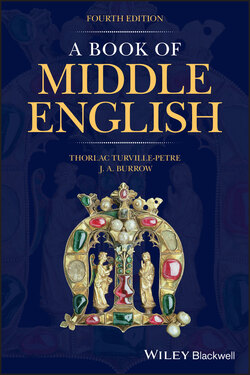Читать книгу A Book of Middle English - J. A. Burrow - Страница 69
5.6 Verbs 5.6.1 Use of Present Tense
ОглавлениеEnglish has only two tense‐forms, present and past. The present tense expresses habitual action and general truths: þu chaterest so doþ on Irish prost, ‘you chatter like an Irish priest’, 2/322; wel fiʒt þat wel fliʒt, ‘well fights that well flees’ (proverbial), 2/176. In Middle English the simple present is also used where Modern English has the progressive ‘am’ + ‘‐ing’, to express an action that is in progress over a limited period: al dares for drede, ‘they are all cowering for fear’, 9/315.
As in Old English, the present tense is frequently used to refer to the future: þay ta me bylyve, ‘they will seize me at once’, 8/78. Nearly always the context makes it quite clear that the action is in the future, for example with an expression of time: we foure rayse it noʒt right to‐yere, ‘the four of us will not raise it upright this year’, 15/164. Compare ‘I go to London tomorrow’ in Modern English.
The historic present, not found in Old English, becomes common in the later fourteenth century, particularly in narrative of past events in order to place reader and writer in the middle of the action: þer hales in at þe halle dor an aghlich mayster, ‘there comes in at the hall door a fearsome knight’, 9/136. In relating a series of such events, the writer may switch quite freely between past tense and historic present; see for example the description of Jonah entering the whale’s mouth, 8/246–53.
